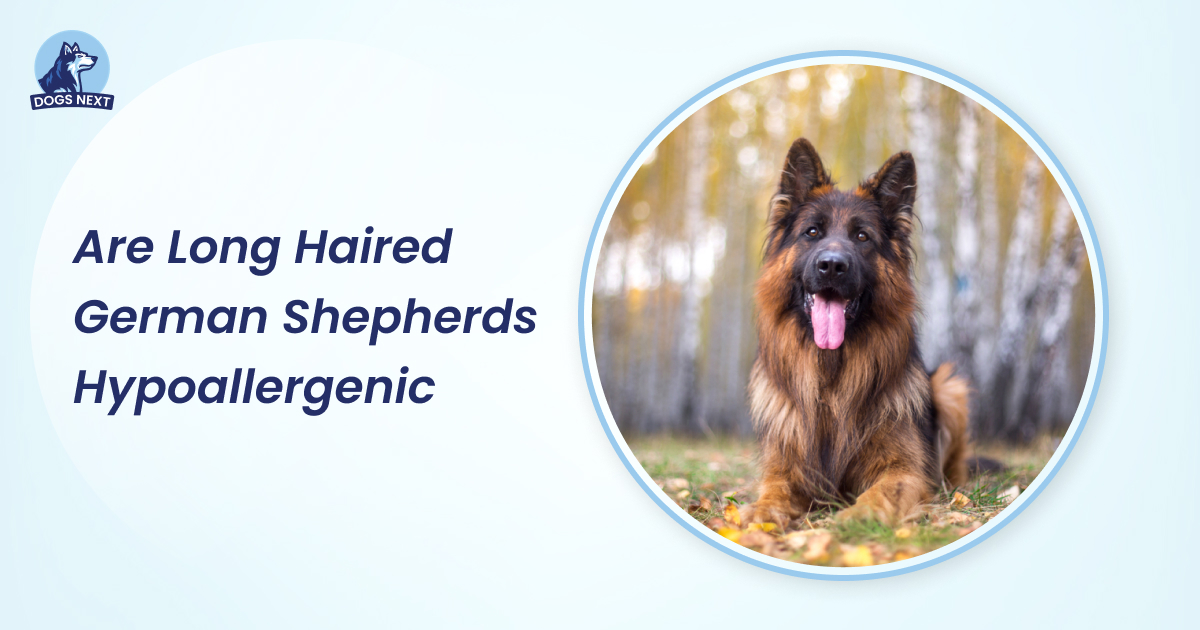No, long-haired German Shepherds are not hypoallergenic. They shed heavily and produce dander, which can trigger allergies.
Long-haired German Shepherds are a beautiful variation of the standard German Shepherd breed. Known for their loyalty and intelligence, they make excellent family pets and working dogs. These dogs have a double coat, which requires regular grooming to manage shedding.
Long-haired German Shepherds can be prone to causing allergies due to their shedding and dander production. Regular grooming and cleaning can help manage allergens, but they are not suitable for people with severe allergies. Understanding the grooming needs and potential allergy issues is crucial for prospective owners. This knowledge ensures a happy and healthy relationship with your long-haired German Shepherd.
Understanding Allergies And Dog Breeds
Are Long-Haired German Shepherds Hypoallergenic? Many potential dog owners grapple with this question. Understanding allergies and dog breeds can help you make an informed decision. Dog allergies are common, but not all dogs trigger the same allergic reactions. Some breeds are considered hypoallergenic. Knowing the difference between allergens in fur and dander is crucial.
Allergens In Fur Vs. Dander
People often think dog fur causes allergies. In reality, pet dander allergens are the main culprits. Dander consists of tiny flakes of skin shed by animals. These flakes can trigger allergic reactions in sensitive individuals.
Here are some key points to consider:
- Dog fur itself is not the allergen. Instead, it carries dander, saliva, and urine.
- Dander is lightweight and can become airborne. It can stick to furniture, bedding, and clothing.
- Long-haired German Shepherds may seem more allergenic. Their long fur can trap more dander.
It’s essential to understand that even hypoallergenic dog breeds produce some dander. These breeds typically shed less, reducing the amount of dander in the environment.
Here’s a simple table explaining the difference:
| Factor | Fur | Dander |
| Composition | Hair strands | Skin flakes |
| Allergen | No | Yes |
| Airborne | No | Yes |
| Visibility | Yes | No |
Common Allergy Misconceptions
There are many misconceptions about pet allergies. These can lead to confusion and poor decisions when selecting a dog breed.
Here are some common myths:
- Myth: Only fur causes allergies. Truth: Dander, saliva, and urine are the primary allergens.
- Myth: Hypoallergenic dog breeds are 100% allergen-free. Truth: All dogs produce some allergens, though hypoallergenic breeds shed less dander.
- Myth: Bathing dogs frequently will eliminate allergens. Truth: Over-bathing can irritate a dog’s skin, potentially increasing dander production.
Understanding these hypoallergenic dog facts can ease pet allergy concerns. It helps in making better decisions about dog ownership. Always consider personal allergies and sensitivities before choosing a pet.
Here’s a simple list of hypoallergenic dog breeds for reference:
- Poodle
- Schnauzer
- Maltese
- Bichon Frise
- Portuguese Water Dog
Educating yourself about pet allergies can lead to a happier, healthier life with your new furry friend.
Do Long-haired German Shepherds Shed Less?
Are Long-Haired German Shepherds Hypoallergenic? Many people adore these majestic dogs but wonder if their long fur affects allergies. One common question is: Do Long-Haired German Shepherds Shed Less? This is a crucial factor for those with allergies, as shedding impacts dander distribution in the home.
Impact Of Long Hair On Shedding
Long-Haired German Shepherds are beautiful with their flowing coats. But does long hair mean less shedding? Unfortunately, no. The length of a dog’s hair doesn’t reduce shedding frequency. In fact, these dogs shed quite a bit.
Their shedding can be broken down into two main periods:
- Seasonal shedding: During spring and fall, they shed more to prepare for the changing temperatures.
- Year-round shedding: Even outside of these seasons, they shed regularly.
This means that their long hair is constantly falling out and can accumulate quickly around the home.
Here is a quick comparison of shedding between short-haired and long-haired German Shepherds:
| Type | Shedding Level |
| Short-Haired | Moderate to High |
| Long-Haired | High |
As you can see, long hair doesn’t mean less shedding. Instead, it means more fur to manage.
Grooming Needs And Fur Management
Long-Haired German Shepherds have specific grooming needs to manage their shedding. Regular grooming is essential to keep their coat healthy and reduce the amount of fur that ends up in your home.
Here are some grooming tips:
- Brushing: Brush your dog at least 3-4 times a week. This helps remove loose hair and prevents mats and tangles.
- Bathing: Bathe your German Shepherd every 6-8 weeks. Use a dog-friendly shampoo to keep their coat clean and healthy.
- Trimming: Regularly trim the fur around their paws and ears to prevent dirt buildup and matting.
Using the right grooming tools can make a big difference:
| Tool | Purpose |
| Slicker Brush | Removes loose fur and detangles |
| Undercoat Rake | Removes dead undercoat hair |
| Scissors/Trimmers | Trims excess fur |
By following these grooming steps, you can manage the shedding and keep your home cleaner. This is especially important for those who suffer from allergies.
Dander Exposure From Long Hair
Dander is a major concern for allergy sufferers. It is made up of tiny, even microscopic, bits of skin shed by cats, dogs, rodents, birds and other animals with fur or feathers.
Long-Haired German Shepherds can produce a lot of dander. Their long fur traps and holds onto these particles. When the hair falls out, dander spreads around your home.
Here are some ways to reduce dander exposure:
- Frequent Cleaning: Vacuum your home regularly to pick up loose hair and dander. Use a vacuum with a HEPA filter for best results.
- Air Purifiers: Install air purifiers in rooms where your dog spends the most time. These devices can help reduce airborne dander.
- Wash Bedding: Wash your dog’s bedding and your own regularly. This removes dander that has settled into fabrics.
- Limit Access: Keep your dog out of certain rooms, like bedrooms, to reduce dander in those areas.
Reducing dander exposure is crucial for those with allergies. It can make living with a Long-Haired German Shepherd more comfortable.
Tips For Reducing Allergies With Long-haired German Shepherds
Long-haired German Shepherds are known for their beautiful coats, but they can also pose challenges for allergy sufferers. While these dogs are not hypoallergenic, there are ways to manage and reduce allergy symptoms. Here are some effective tips for reducing allergies with long-haired German Shepherds.
Frequent Grooming And Cleaning
Regular grooming is crucial in pet grooming for allergies. Brushing your long-haired German Shepherd daily helps remove loose fur and dander. This reduces the amount of allergens in your home. Frequent baths also help minimize dander. Use hypoallergenic shampoos to avoid irritating your dog’s skin.
- Daily brushing: Use a high-quality brush to remove loose fur.
- Weekly baths: Use a mild, hypoallergenic shampoo to reduce dander.
- Cleaning tools: Clean brushes and grooming tools regularly to prevent allergen buildup.
Cleaning your dog’s bedding and toys is also essential. Wash their bedding weekly in hot water to kill allergens. Vacuuming your home frequently with a HEPA filter vacuum can help capture dander and hair.
Using Air Filters At Home
Air filters can significantly reduce allergens in your home. HEPA air purifiers are highly effective in trapping pet dander, dust, and other allergens. Place air purifiers in common areas where your dog spends most of their time.
- HEPA air purifiers: Invest in high-quality HEPA air purifiers for living rooms and bedrooms.
- Change filters regularly: Follow the manufacturer’s instructions to change filters on time.
- Strategic placement: Position air purifiers where your dog spends most of their time.
Consider using air filters in your HVAC system. This can help reduce allergens circulating throughout your home. Clean or replace HVAC filters monthly for maximum efficiency.
Allergy-friendly Cleaning Practices
Adopting allergy-friendly cleaning practices can make a big difference. Use microfiber cloths to dust surfaces. They are more effective at trapping dust and dander than traditional dusters. Wet mopping floors can also help reduce allergens.
- Microfiber cloths: Use these for dusting to capture more allergens.
- Wet mopping: Mop floors with water to pick up dander and dust.
- Vacuuming with HEPA filters: Ensure your vacuum has a HEPA filter to trap allergens.
Wash curtains and upholstery regularly. These fabrics can trap pet dander and dust. Consider using allergen-proof covers for mattresses and pillows to reduce exposure to allergens. Implement these allergy prevention tips to create a more allergy-friendly home environment.
Incorporate these allergy-friendly pet care practices to manage dog allergies effectively. Regular grooming, air filtration, and diligent cleaning can make living with a long-haired German Shepherd more comfortable for allergy sufferers.
Frequently Asked Questions
Are Long-haired German Shepherds Hypoallergenic?
No, long-haired German Shepherds are not hypoallergenic. They shed heavily, which can trigger allergies in sensitive people.
Do Long-haired German Shepherds Shed A Lot?
Yes, long-haired German Shepherds shed significantly. Regular grooming can help manage the shedding and keep your home cleaner.
Can Allergies Be Managed With Long-haired German Shepherds?
Yes, allergies can be managed with regular grooming and cleaning. Using air purifiers can also help reduce allergens in the home.
What Grooming Does A Long-haired German Shepherd Need?
Long-haired German Shepherds need regular brushing, at least 2-3 times a week. This helps manage shedding and prevents matting.
Conclusion
Long-haired German Shepherds are not hypoallergenic. They shed heavily, which can trigger allergies. Regular grooming helps manage shedding. If you have allergies, consider another breed. Always consult a veterinarian for personalized advice. Understanding a breed’s characteristics ensures a harmonious relationship with your pet.

I’m David, an expert contributor and writer, with two furry friends of my own, I know the challenges of raising and caring for dogs. From training to nutrition and health, my goal is to provide valuable insights and advice to help create strong bonds and happy, healthy lives. Find me in Twitter.




